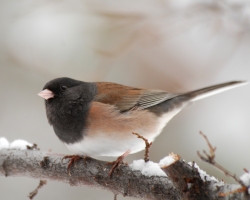
Courtesy US FWS
Carla Stanley, Photographer

Another fascinating discovery was how different individual juncos were as I handled those captured in a mist net for banding purposes. Some were quite belligerent biting and struggling throughout the experience. Others were very docile. I imagined them to be smiling throughout the ordeal.
The Dark-eyed Junco can be found across the continent, from Alaska to Mexico, from California to New York. A recent estimate set the junco’s total population at approximately 630 million individuals, about double the U.S. human population.
Belonging to the sparrow family Passerellidae, Junco systematics are still confusing after decades of research, with various authors accepting between three and 12 species. There is a huge range of geographic variation in the Dark-eyed Junco. Among the 15 described races, six forms are easily recognizable in the field and five used to be considered separate species until the 1980s.
Primarily ground feeders, in winter they become highly social often foraging in flocks, evident as masses attack my feeder, and each other! Their breeding habitat is coniferous or mixed forest areas, ranging from subarctic taiga to high-altitude mountain forests in Mexico and Central America south to Panama. The Oregon Dark-eyed Junco, along with the Slate-colored, are the two most widely known subspecies.
The oldest recorded Dark-eyed Junco was at least 11 years, 4 months old when it was recaptured and rereleased during banding operations in West Virginia in 2001.
Juncos are described as “happy, bubbly, little birds that are a joy to watch”. All races and species share a pink bill as well as pink legs, a reminder that no matter how different two things look, they are not all that different on the inside. Please enjoy your juncos and happy holidays!
Jack Greene for Bridgerland Audubon Society, and I’m always wild about wild things in Utah!
Credits:
Nest Picture: Courtesy US FWS, Carla Stanley, Photographer
Junco Picture: Courtesy & © Ryan P O’Donnell, Photographer
Audio: Courtesy and Copyright Kevin Colver
Text: Jack Greene, Bridgerland Audubon Society
Additional Reading: Lyle W Bingham, Webmaster
Additional Reading:
Liberatore, Andrea, Dark-Eyed Juncos, Wild About Utah, January 12, 2012, https://wildaboututah.org/dark-eyed-juncos/
Greene, Jack, Seasonal Changes and Amazing Adaptations, Wild About Utah, Nov 9, 2015, https://wildaboututah.org/seasonal-changes-amazing-adaptations/
Atwell, J.W., O’Neal, D.M, and Ketterson, E.D. (2011) Animal Migration as a Moving Target for Conservation: Intra-species Variation and Responses to Environmental Change, as Illustrated in a Sometimes Migratory Songbird. Environmental Law. Vol. 41:289 p. 289-319, https://www.amazon.com/Animal-migration-moving-target-conservation/dp/B005C29H7I
Alderfer, Jonathan (editor) (2005) National Geographic Complete Book of Birds. National Geographic Press. Dark-eyed junco information available online at: https://animals.nationalgeographic.com/animals/birding/dark-eyed-junco/
Cornell Lab of Ornithology, All About Birds: Dark-eyed Junco. https://www.allaboutbirds.org/guide/Dark-eyed_Junco/id/ac
History of Name Changes for Juncos. Cornell Lab of Ornithology. https://www.birds.cornell.edu/pfw/News/junco_taxonomy.pdf
